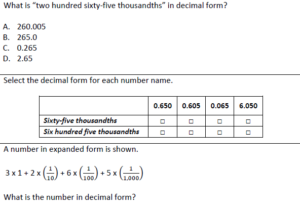Read, write, and compare decimals to thousandths.
a. Read and write decimals to thousandths using base-ten numerals, number names, and expanded form, e.g., 347.392 = 3 × 100 + 4 × 10 + 7 × 1 + 3 × (1/10) + 9 × (1/100) + 2 × (1/1000).
[divider] [/divider]
Students are able to…
- Read decimals appropriately. Reading 4.56 as “four point five six” has no meaning and does not support understanding of decimal values. Students should read decimals in their entirety, for example, “Four and fifty-sixth hundredths”, understanding that the fifty-sixth hundredths could be written as
- Recognize and name base-ten numerals to the thousandths place using place value charts and expanded form.
- Demonstrate understanding of the value of a number represented with base-ten models and write base-ten numerals on a place value chart.
Students are able to…because teachers:
- Provide students with a variety of experiences in which students model and write base-ten numerals on a place value chart.
- Engage students in discussion to connect models on place value charts with writing decimal numbers in expanded notation.
- Demonstrate how to read decimals appropriately using place value and writing decimal names in words. Emphasize the importance of reading decimals correctly to be a model for students.
- Showcase decimal place names (tenths, hundredths, thousandths) on the word wall and refer to them regularly to encourage proper reading of decimal numerals.
[divider] [/divider]
Questions to ask students:
- Write the numeral 134.278 in expanded form.
- Sample answer that indicates understanding: 100 + 30 + 4 + 2 x + 7 × + 8 × .
- Sample answer that indicates an incomplete understanding or a misconception: 100 + 30 + 4 + 2 + 7 + 8 or 100 + 30 + 4 + 200 + 70 + 8
- Read aloud the numeral 134.278
- Sample answer that indicates understanding: One hundred thirty-four and two hundred seventy-eight thousandths
- Sample answer that indicates an incomplete understanding or a misconception: One hundred and thirty-four point two seventy-eight
[divider] [/divider]
FSA Notes
Cognitive Complexity Level: Level 2: Basic Application of Skills & Concepts
Achievement Level Descriptors:
Level 2: reads and writes decimals using base-ten numerals and number names
Level 3: reads and writes decimals using expanded form; compares two decimals, using > , = , and < symbols to record the results of comparisons
Level 4: writes decimals in expanded form or base-ten numerals in multiple formats
Level 5: compares two decimals that are written in different formats
Assessment Limits: Items may contain decimals to the thousandths with the greatest place value to the millions
Context: Allowable
[divider] [/divider]
Additional Resources:
Additional in depth content knowledge:
http://www.katm.org/flipbooks/5%20FlipBook%20Final%20CCSS%202014.pdf#page=19
Video:
[divider] [/divider]
Sample Formative Tasks: (Click to make the task image larger)

Resources/Tasks to Support Your Child at Home

- While walking around the grocery store or in your house, ask your child to read different items ounces or liters (Ex: a shampoo bottle may be 6.07 oz, it would read as : “six and 7 hundredth ounces”.
- Ask your child to write a certain decimal in expanded form, written form, and decimal form
- Ex: Decimal: 4.135 Written: Four and one hundred thirty-five thousandths, Expanded form: 4 x 1 + 1 x (1/10) + 3 x (1/100) + 5 x (1/1000)